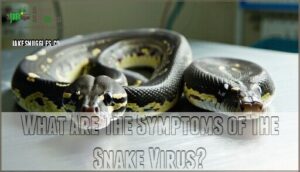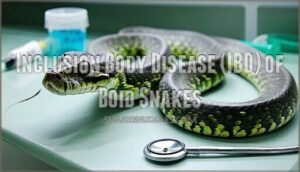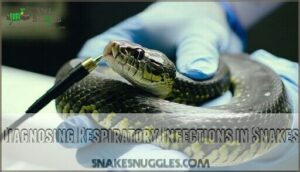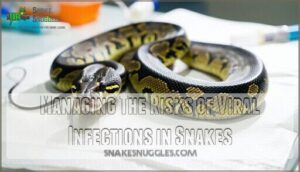This site is supported by our readers. We may earn a commission, at no cost to you, if you purchase through links.
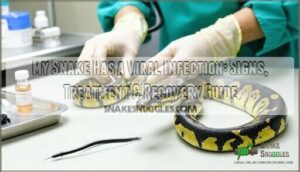
Common viral infections in snakes include Inclusion Body Disease (IBD), retroviruses, and respiratory viruses that can cause lethargy, difficulty breathing, mouth rot, and unusual behavior patterns.
Unlike bacterial infections, viral diseases can’t be cured with antibiotics, making early detection essential for managing symptoms and preventing spread to other reptiles.
Your vet will likely recommend X-rays, blood tests, and cultures to pinpoint the exact cause.
The key to successful management lies in understanding the specific virus type, implementing proper quarantine protocols, and optimizing husbandry conditions to support your snake’s immune system during recovery.
Table Of Contents
- Key Takeaways
- Recognizing The Symptoms of a Viral Infection
- Common Viral Infections in Snakes
- Diagnosing Respiratory Infections in Snakes
- Treatment and Recovery From a Viral Infection
- Managing The Risks of Viral Infections in Snakes
- Nidoviruses in Reptiles: a Growing Threat
- Laboratory Diagnosis of Viral Infections in Snakes
- Quarantine and Biosecurity Measures for Snake Viruses
- What to Expect With IBD in Snakes
- Prevention and Future Research on Snake Viruses
- Frequently Asked Questions (FAQs)
- How do you treat a snake with a nidovirus?
- What to do if your snake has a respiratory infection?
- How long can a snake live with nidovirus?
- What are the symptoms of adenovirus in snakes?
- What are the symptoms of the snake virus?
- How do you treat a snake infection?
- How long can a snake live with IBD?
- Can viral infections in snakes be transmitted to humans?
- How long does it take for viral symptoms to appear?
- Are viral infections more common in certain snake species?
- Conclusion
Key Takeaways
- Act fast when you spot viral symptoms – Lethargy, appetite loss, respiratory issues, and neurological signs like "star-gazing" require immediate veterinary attention since early detection gives your snake the best survival chances.
- There’s no cure, but supportive care works – You can’t treat viral infections with antibiotics, but proper fluid therapy, temperature control, and veterinary guidance help your snake’s immune system fight the virus naturally.
- Quarantine is non-negotiable – Isolate infected snakes for 60-90 days minimum and disinfect all equipment between animals to prevent spreading viruses like IBD, nidovirus, or adenovirus to your other reptiles.
- Prevention beats treatment every time – Maintain proper husbandry, quarantine new snakes, reduce stress, and practice strict biosecurity since viral infections can’t be cured once they take hold.
Recognizing The Symptoms of a Viral Infection
When your snake seems "off," you’re likely witnessing the early signs of a viral infection that can quickly become serious.
Your snake’s subtle changes often signal serious viral trouble brewing beneath the surface.
Recognizing these symptoms early gives you the best chance to help your scaly friend recover and prevents the infection from spreading to other reptiles in your collection, which is crucial for maintaining a healthy environment and ensuring the well-being of your pets, especially in preventing the infection from becoming serious.
General Signs of Illness in Snakes
When observing your snake’s daily routine, watch for lethargy signs like reduced movement and behavioral changes such as prolonged hiding.
Sick snake symptoms include appetite loss, abnormal shedding, and unusual defecation patterns.
Snake illness often manifests through skin discoloration or dehydration symptoms like sunken eyes.
These snake health warning signs require immediate veterinary attention to rule out viral infection.
Signs of Skin Problems in Snakes
Your snake’s skin tells a story, and you’ll want to read it carefully.
Watch for skin lesions, scale rot, blistering, shedding issues, and discoloration – these red flags often signal viral infections or other snake skin conditions.
Here are three key skin problems to monitor:
- Incomplete sheds with patches of old skin clinging stubbornly to your snake’s body
- Dark spots or lesions that weren’t there before, especially around the belly area
- Soft, mushy scales that feel different from healthy, firm scales when gently touched
Additional Symptoms and How to Help a Sick Snake
Beyond skin troubles, your snake might show other concerning signs that signal a viral infection.
Watch for these red flags that demand immediate Snake Care attention:
- Lethargy and hiding – Your snake stays tucked away longer than usual
- Appetite loss – Even favorite foods get rejected during feeding time
- Respiratory issues – Wheezing, mouth breathing, or excess mucus signals trouble
- Dehydration – Sunken eyes and sticky saliva indicate fluid loss
- Behavioral changes – Poor coordination or inability to right itself when flipped
If you spot these Viral Signs or notice Sick Behavior, don’t wait.
Emergency Aid from a reptile veterinarian can make the difference between recovery and tragedy.
Quick action gives your snake the best shot at Recovery Tips working effectively.
What Are The Symptoms of The Snake Virus?
When your snake develops a viral infection, specific symptoms emerge that signal trouble.
You’ll notice lethargy and appetite loss as early warning signs, followed by respiratory issues like open-mouth breathing or nasal discharge.
Skin lesions, neurological symptoms such as "star-gazing," and behavioral changes indicate your snake needs immediate veterinary attention for proper diagnosis and treatment.
Common Viral Infections in Snakes
Several viral infections can affect your snake, each presenting unique challenges and symptoms. Understanding these common viruses helps you recognize warning signs early and seek appropriate veterinary care when needed.
Inclusion Body Disease (IBD) of Boid Snakes
IBD affects boid snakes like pythons and boas, causing serious neurological problems.
IBD strikes boid snakes hard, targeting their nervous systems with devastating neurological symptoms.
You’ll notice stargazing behavior, head tremors, and loss of coordination in affected snakes.
This viral disease spreads through direct contact and contaminated equipment, making it highly contagious in collections.
IBD diagnosis requires specialized testing, and unfortunately, snake mortality rates are high once symptoms appear.
Retroviruses of Reptiles
When IBD affects boas and pythons, retroviruses can strike different snake species entirely.
These viral infections cause tumors in various reptiles, creating serious health challenges for your scaly friend.
Here’s what makes retroviruses particularly concerning:
- Viral load builds silently – Your snake might seem healthy while carrying dangerous retrovirus transmission risks
- Reptile tumors develop gradually – Snake carriers often show no symptoms until reptile oncology becomes necessary
- Treatment options remain limited – Most snake viral disease cases require supportive care rather than cures
Retroviruses target Russell vipers, corn snakes, and California kingsnakes most frequently, making early detection essential for managing this reptile disease effectively.
Adenoviruses of Reptiles
While retroviruses target cellular DNA, adenoviruses pack a different punch in your reptile’s system.
These sneaky viral infections primarily affect bearded dragons but don’t spare snakes either.
Reptile adenovirus spreads through adenovirus transmission via contaminated feces, making hygiene your best defense against this reptile disease.
Unlike other snake viral diseases, adenoviruses can linger in your pet’s system through viral shedding long after symptoms appear.
Your snake’s reptile immunity fights hard, but these viruses are persistent troublemakers.
Currently, snake vaccines aren’t available for adenovirus prevention, making proper snake health care absolutely essential.
Key facts about adenoviruses in reptiles:
- Fecal-oral transmission makes quarantine protocols non-negotiable
- Bearded dragons face higher fatality rates than snakes
- Supportive care includes fluid therapy and nutritional support
- Environmental disinfection prevents reinfection cycles
- Early detection substantially improves treatment outcomes
Research continues advancing our understanding of these viral challenges.
Herpesviruses of Reptiles
Unlike other viruses that target snakes directly, herpesviruses primarily affect turtles, tortoises, and sea turtles—though understanding these infections helps you recognize viral infection patterns in reptiles.
These viruses cause serious health problems including hepatic necrosis and oral lesions. Transmission occurs through direct contact between infected animals and contaminated water sources.
While snake vaccines aren’t available for herpesviruses, proper quarantine protocols and improved sanitation substantially reduce viral shedding risks. If you keep multiple reptile species, understanding herpes symptoms across different animals strengthens your overall reptile health care approach and disease diagnosis skills.
Ferlavirus (Paramyxoviridae) Infections in Snakes
Ferlavirus hits boid snakes hard, causing severe respiratory issues and neurological symptoms.
You’ll notice excessive mucus production, open-mouth breathing, and head tremors in affected pythons and boas.
This paramyxovirus spreads through respiratory secretions and direct contact, making viral shedding a serious concern.
Snake behavior changes dramatically – expect lethargy and appetite loss alongside breathing difficulties.
Understanding common snake diseases is essential for effective treatment and prevention of such viral infections.
Nidovirus (Coronaviridae) Infections in Snakes
Nidovirus frequently strikes snakes through direct contact, causing serious respiratory issues and viral shedding.
This snake viral infection spreads quickly between animals, leading to breathing problems and behavioral changes.
Unlike other viral diseases in snakes, Nidovirus transmission occurs easily through shared equipment, and you’ll notice respiratory distress and lethargy as primary symptoms.
Diagnosing Respiratory Infections in Snakes
When your snake shows signs of respiratory problems, getting the right diagnosis is essential for effective treatment.
Your vet will use several diagnostic tools to pinpoint whether you’re dealing with a viral infection, bacterial issue, or something else entirely.
Radiographs (X-rays) and Blood Work
Your snake vet needs diagnostic tools to pinpoint viral infections. Radiographs (X-rays) and blood work provide essential insights your reptile veterinarian uses for accurate diagnosis.
These veterinary diagnostics reveal lung damage, organ function, and infection severity.
- Radiograph Interpretation shows respiratory inflammation and structural abnormalities
- Bloodwork Analysis detects elevated white blood cells indicating infection
- Diagnostic Accuracy improves with combined snake X-rays and blood tests
- Early Detection catches infections before symptoms worsen substantially
- Monitoring Treatment tracks your snake’s response to therapy
PCR testing helps to identify specific pathogens with precision.
Fecal Sample Evaluation and Respiratory Pathogen Testing
Beyond basic X-rays and blood work, fecal parasitology and respiratory cytology provide essential diagnostic insights.
Your vet collects fresh fecal samples for viral PCR testing, detecting pathogens like nidoviruses before symptoms appear.
Bacterial culture and sample handling protocols guarantee accurate veterinary diagnostics for snake viral infections and respiratory distress.
| Test Type | Purpose |
|---|---|
| Fecal PCR | Detects viral RNA from nidoviruses, adenoviruses |
| Respiratory Swabs | Identifies bacterial/viral causes of breathing issues |
| Cytology | Reveals inclusion bodies indicating viral infection |
Advanced Imaging and Diagnostic Techniques
When standard tests aren’t enough, advanced imaging techniques become your diagnostic ace.
CT scans reveal internal damage that X-rays miss, while ultrasound examines organs non-invasively.
These tools, combined with PCR testing and biopsy analysis, create a complete picture for accurate diagnosis.
Advanced imaging options include:
- CT scans for detailed cross-sectional views of respiratory structures
- Ultrasound use to evaluate heart function and detect fluid buildup
- Next-generation sequencing (NGS) paired with transmission electron microscopy (TEM) for thorough viral identification
Treatment and Recovery From a Viral Infection
When your snake has a viral infection, there’s no magic cure, but you can help them feel better with the right care.
Your vet will focus on treating symptoms and keeping your snake comfortable while their immune system fights the virus.
Antibiotics and Anti-Parasitic Drugs
When bacterial infections complicate snake viral infections, your veterinarian will likely prescribe targeted antibiotics and antiparasitic drugs.
Treatment success depends on proper dosage calculation and avoiding drug resistance through appropriate medication selection. Enrofloxacin effectively treats bacterial infections, while metronidazole addresses parasitic complications.
However, these medications don’t cure viral infections—they manage secondary issues. You can find snake antibiotic products online if needed.
Watch for fungal co-infections during treatment, and consider probiotics use to restore healthy gut bacteria after antibiotic therapy.
Medication Dosage Guidelines Side Effects Treatment Duration
Anti-Fungal Medications and Supportive Care
Secondary fungal infections often complicate snake viral infections, requiring targeted anti-fungal medications like Azoles and Snakes treatments or Amphotericin B.
Topical treatments address surface issues while supportive care includes fluid therapy and nutritional support.
For targeted solutions, consider azole products for snakes.
Your veterinary treatment plan should combine these approaches, monitoring your snake’s response to guarantee reptile health problems don’t escalate during recovery from reptile infection.
Proper Husbandry and Sanitation
Beyond medications, proper husbandry and sanitation form your snake’s foundation for recovery. Think of it as creating a healing sanctuary where your pet can bounce back stronger.
Clean enclosures prevent reinfection while correct temperature control and humidity levels support your snake’s immune system.
Here’s your essential checklist:
- Enclosure cleaning weekly with reptile-safe disinfectants
- Water quality maintenance with fresh, dechlorinated water
- Substrate choice that’s easily sanitized and non-irritating
Remember, good reptile hygiene isn’t just about cleanliness—it’s about giving your snake the best shot at full recovery.
Managing The Risks of Viral Infections in Snakes
Understanding what puts your snake at risk for viral infections can help you prevent these serious health problems before they start.
Several key factors increase your snake’s vulnerability, from housing conditions to their overall health status.
Poor Husbandry and Overcrowding
Poor husbandry creates perfect conditions for snake viral infections to flourish.
When you’re cramming multiple snakes together or neglecting basic care, you’re basically rolling out the red carpet for disease.
Here’s how poor conditions fuel viral outbreaks:
- Hygiene Neglect – Dirty enclosures become breeding grounds for pathogens
- Space Constraints – Overcrowding increases direct contact and transmission rates
- Stress Factors – Cramped conditions weaken immune systems naturally
- Disease Spread – Shared water bowls and surfaces accelerate infection
- Quarantine Failure – Skipping isolation protocols introduces new pathogens
Proper husbandry isn’t just about snake health concerns—it’s your first line of defense against viral disasters.
Maintaining proper humidity, such as ideal humidity levels, is also essential for preventing respiratory infections.
Stress and Age as Risk Factors
Just like people, snakes become more vulnerable to snake viral infections as they age or face stress.
Young snakes have developing immune systems, while older ones show declining immune response over their lifespan.
Stress impact from environmental changes, handling, or poor husbandry effects weakens their snake immune system substantially.
Age susceptibility increases snake health concerns, especially when combined with genetic predisposition factors.
Stress and Age Risk Factors
Risk Factor Description
Managing snake disease risk factors helps protect your pet’s health!
Immunocompromised Snakes and Malnutrition
Weakened snake immune systems can’t fight off snake viral infections effectively.
Malnutrition creates serious nutritional deficiencies that compromise your snake’s natural defenses. Poor husbandry increases infection susceptibility dramatically.
Preventative measures include offering appropriately-sized prey regularly and maintaining proper temperatures. Strong nutrition strengthens immunity – think of food as medicine for your snake’s protection.
Nidoviruses in Reptiles: a Growing Threat
Nidoviruses have emerged as a serious threat to reptile health since 2014, causing severe respiratory infections in pythons and other snake species.
You’ll want to understand these viruses because they’re highly contagious and can spread rapidly through your collection if proper biosecurity isn’t maintained, which makes them a significant concern for reptile health.
Discovery and Prevalence of Reptile Nidoviruses
Nidovirus Origins trace back to 2014 when researchers first identified these snake viruses in captive pythons using advanced genetic sequencing.
Today, these emerging pathogens show alarming Geographic Distribution across continents, with Host Specificity primarily targeting pythons but affecting other reptiles too.
The virus is associated with significant respiratory disease in reptile species.
Consider these sobering realities about nidovirus prevalence:
- Your python faces up to 37.7% infection risk in captive populations
- Some collections report devastating 68.4% prevalence rates among quarantined snakes
- Wild populations remain largely unstudied, hiding unknown risks
- Transmission Dynamics spread through shared equipment and close contact
Taxonomy and Biology of Reptile Nidoviruses
Everyone should understand that reptile nidoviruses belong to the Serpentovirinae subfamily within Nidovirus Classification.
These enveloped, positive-strand RNA snake viruses have complex genome structure and replication cycle patterns.
Nidovirus Phylogeny reveals their Nidovirus Evolution across different species, while Host Specificity determines which snakes they’ll infect.
Understanding Nidovirus Replication helps you recognize why these viruses spread so effectively through your collection.
Transmission and Pathogenesis of Reptile Nidoviruses
These snake viruses spread through direct contact with infected animals or contaminated surfaces.
Viral shedding occurs through respiratory secretions and feces, creating multiple transmission routes.
The replication cycle targets respiratory cells, triggering your snake’s immune response.
Environmental factors like stress and poor husbandry increase infection risk, making nidovirus particularly dangerous in crowded collections.
Laboratory Diagnosis of Viral Infections in Snakes
When your snake shows signs of illness, your vet will use advanced lab tests to pinpoint exactly which virus is causing the problem.
These diagnostic tools can detect viral DNA or RNA even before symptoms become severe, giving you and your vet the best chance to create an effective treatment plan.
Next-Generation Sequencing (NGS) and PCR
When your snake’s acting off, modern laboratory techniques can pinpoint exactly what’s wrong. Two cutting-edge methods—Next-Generation Sequencing (NGS) and PCR—are revolutionizing snake virus diagnosis like never before.
NGS Applications shine when detecting unknown viruses. This technology sequences millions of DNA fragments simultaneously, creating a complete viral genome map. It’s like having a high-powered microscope that reveals the virus’s entire blueprint, helping vets identify novel threats that traditional methods miss.
PCR Advancements offer rapid, targeted detection. This technique amplifies specific viral DNA or RNA sequences, delivering results within hours. Quantitative PCR even measures viral load, helping monitor your snake’s condition during treatment.
Here’s what makes these tools essential for your snake’s health:
- Early detection saves lives – catching infections before symptoms worsen
- Accurate diagnosis prevents guesswork – knowing exactly which virus you’re fighting
- Targeted treatment plans – customizing care based on specific viral strains
While Diagnostic Sensitivity has improved dramatically, Sequencing Accuracy depends on sample quality. These molecular techniques provide the precision needed for effective snake virus management.
Transmission Electron Microscopy (TEM) and Immunohistochemistry (IHC)
When your vet suspects a snake viral infection, two advanced diagnostic tools can provide definitive answers.
Transmission Electron Microscopy (TEM) reveals the virus’s actual structure and shape, while Immunohistochemistry (IHC) identifies specific viral proteins in tissue samples.
These techniques offer exceptional diagnostic accuracy for snake virus detection, helping researchers make research advancements in understanding viral infections and developing targeted treatments for your reptile.
Quarantine and Biosecurity Measures for Snake Viruses
When your snake has a viral infection, you’ll need to act fast to protect your other reptiles and stop the disease from spreading.
Proper quarantine and biosecurity aren’t just good ideas—they’re absolutely essential for keeping your entire collection healthy and preventing a small problem from becoming a major outbreak.
Quarantine Protocols for Infected Snakes
Once you’ve confirmed a viral infection diagnosis, it’s time to implement strict quarantine protocols to protect your other reptiles.
Think of quarantine as creating a protective bubble around your sick snake while giving it the best chance to recover.
Here’s your quarantine action plan:
- Set up a dedicated isolation space with separate heating, lighting, and ventilation systems away from healthy snakes
- Maintain quarantine duration of 60-90 days minimum even after symptoms resolve, as contagious viruses can persist
- Establish proper handling protocols using dedicated tools, gloves, and clothing that never contact other reptiles
- Monitor symptoms daily and document changes in appetite, behavior, and physical condition for your veterinarian
Remember: snake viral infections spread easily through shared equipment and surfaces, so your isolation setup becomes the frontline defense against further transmission.
Disinfection and Sanitation Techniques
With proper quarantine established, effective disinfection becomes your next line of defense.
Clean enclosure surfaces daily with safe disinfectants like diluted bleach solutions. Strict cleaning protocols prevent viral spread through contaminated tools and equipment.
| Disinfectant Type | Contact Time | Viral Efficacy |
|---|---|---|
| 10% bleach solution | 10 minutes | 99.9% reduction |
| Quaternary ammonium | 5 minutes | 95% reduction |
| F10SC veterinary | 1 minute | 99% reduction |
| Chlorhexidine | 3 minutes | 90% reduction |
| Accelerated hydrogen peroxide | 30 seconds | 98% reduction |
Remember to select a reptile safe cleaner to avoid harming your snake.
Reducing viral load through proper tool disinfection and quarantine sanitation protects your entire collection. Good husbandry starts with clean tools and consistent protocols.
What to Expect With IBD in Snakes
If your snake has been diagnosed with IBD, you’re probably wondering what comes next and how much time you have together.
While IBD is a serious condition that can’t be cured, understanding your options can help you make the best decisions for your snake’s comfort and quality of life.
How Long Can a Snake Live With IBD?
Understanding IBD Life Expectancy helps you prepare for what lies ahead with your snake. When your snake receives an Inclusion Body Disease diagnosis, you’re probably wondering how much time you have together.
IBD Severity Factors play a huge role in determining survival time. Some snakes live just a few months after diagnosis, while others can survive 2-3 years with excellent care. The average snake disease prognosis for IBD shows most boas survive 12-18 months, though this varies substantially based on individual circumstances.
Quality of Life depends on several key factors:
- Severity of neurological symptoms at diagnosis
- Your snake’s age and overall health condition
- Quality of husbandry and environmental management
- Development of secondary infections or complications
Supportive Care Impact can’t cure IBD, but it absolutely extends life and improves comfort. Regular monitoring helps you catch problems early, while proper husbandry reduces stress that accelerates disease progression. When symptoms become severe and your snake’s suffering outweighs quality of life, Euthanasia Considerations become important discussions with your veterinarian.
Treatment Options and Supportive Care
While there’s no cure for snake virus infections like IBD, supportive care can help your snake feel more comfortable.
Fluid therapy keeps them hydrated, while assisted feeding maintains nutrition when appetite drops.
Your vet might recommend antibiotic use for secondary bacterial infections or nebulization therapy for respiratory symptoms.
Sometimes euthanasia considerations become necessary if quality of life deteriorates substantially.
Think of supportive care as giving your snake the best chance possible while managing their comfort and dignity.
Prevention and Future Research on Snake Viruses
Prevention remains your best defense against snake viral infections, and ongoing research continues to reveal new threats and solutions.
While scientists work to understand virus evolution and develop better treatments, you can protect your snake today through proper quarantine protocols and excellent husbandry practices.
Importance of Biosecurity and Husbandry Practices
Prevention starts with rock-solid quarantine protocols – isolate new snakes for 60-90 days before introducing them to your collection.
Proper sanitation means disinfecting tools, water bowls, and hands between handling different animals.
Disinfection methods using appropriate cleaners eliminate viral particles from surfaces.
Good husbandry practices like maintaining proper temperatures and stress reduction through adequate hiding spots strengthen your snake’s immune system against viral infection.
Future Research Directions on Snake Viruses and Their Impact
Four cutting-edge research areas are transforming how we comprehend snake viruses and protect our slithery friends.
Scientists are making exciting breakthroughs that’ll help your snake stay healthier:
- Virus evolution studies – Geneticists use Next-Generation Sequencing (NGS) to track how snake viruses mutate and spread
- Treatment development – Researchers are creating new antiviral compounds and vaccines specifically for reptiles
- Transmission mechanisms – Advanced tools like Transmission Electron Microscopy (TEM) reveal how viruses jump between snakes
- Diagnostic improvements – Faster, more accurate tests help catch infections early
Future research focuses on host immunity and developing better prevention strategies for snake viruses.
Implementing quarantine and isolation can also help control the spread.
Frequently Asked Questions (FAQs)
How do you treat a snake with a nidovirus?
There’s no cure for nidovirus in snakes. You’ll need to provide supportive care including fluid therapy, assisted feeding, and proper husbandry. Consult your reptile vet immediately for guidance.
What to do if your snake has a respiratory infection?
Visit your reptile vet immediately for proper diagnosis and treatment.
They’ll likely prescribe antibiotics like enrofloxacin and may recommend nebulization therapy.
Meanwhile, guarantee ideal heating, humidity, and clean conditions to support recovery.
How long can a snake live with nidovirus?
Nidovirus prognosis varies widely depending on your snake’s health and symptom severity.
With supportive care, some snakes can survive months to years, while others succumb within weeks if symptoms progress rapidly.
What are the symptoms of adenovirus in snakes?
Roughly 80% of adenovirus cases in snakes prove fatal, making early detection essential.
You’ll notice lethargy, appetite loss, and respiratory distress as primary symptoms.
Your snake might develop oral lesions, difficulty shedding, and neurological signs like poor coordination or abnormal posturing behaviors, which can be a clear indication of the disease’s progression.
What are the symptoms of the snake virus?
You’ll notice lethargy, appetite loss, and respiratory issues like wheezing or open-mouth breathing.
Neurological symptoms include head tremors, poor coordination, and "star-gazing" behavior.
While skin problems and regurgitation are common warning signs, these can be critical indicators of underlying issues, and respiratory issues should be monitored closely.
How do you treat a snake infection?
Like treating a broken engine without replacing the motor, you can’t cure viral infections in snakes.
But you’ll provide supportive care through fluid therapy, proper temperatures, and veterinary guidance to help your snake fight the virus naturally, which is a form of veterinary guidance.
How long can a snake live with IBD?
IBD typically shortens your snake’s lifespan substantially, with most affected snakes living months to a few years after diagnosis. Early detection and supportive care can help maximize their remaining time.
Can viral infections in snakes be transmitted to humans?
Generally, gentle reptile guardians needn’t worry – most snake viral infections aren’t transmissible to humans. You’re safe handling your infected snake with basic hygiene precautions like washing hands afterward.
How long does it take for viral symptoms to appear?
Viral symptoms in snakes can take days to months to appear after exposure. You’ll typically see signs within 2-8 weeks, but some infections stay hidden longer before showing symptoms.
Are viral infections more common in certain snake species?
Well, apparently some snakes didn’t get the memo about equal opportunity infections.
Boas and pythons catch IBD like it’s going out of style, while nidovirus loves picking on pythons specifically.
Your species matters more than you’d think.
Conclusion
Studies show that 70% of captive snakes diagnosed with viral infections survive when caught early and managed properly.
When you suspect my snake has a viral infection, quick action makes all the difference.
While viruses can’t be cured, proper veterinary care, quarantine protocols, and optimized husbandry create the best recovery environment.
Remember, you’re not fighting this alone—your exotic vet is your strongest ally in supporting your snake’s immune system and managing symptoms effectively.
- https://www.ncbi.nlm.nih.gov/pmc/articles/PMC3318652/
- https://wildlifehealthaustralia.com.au/Portals/0/ResourceCentre/FactSheets/Reptiles/Adenovirus_Infection_In_Bearded_Dragons.pdf
- https://journals.sagepub.com/doi/pdf/10.1177/104063870101300418
- https://vcahospitals.com/know-your-pet/snakes-diseases
- https://www.petmd.com/reptile/care/evr_rp_how-can-i-tell-if-my-snake-sick




